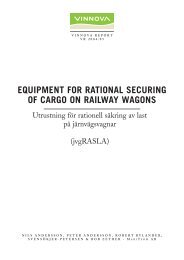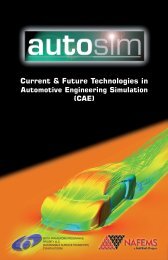WP3: Rail Passenger Transport - TOSCA Project
WP3: Rail Passenger Transport - TOSCA Project
WP3: Rail Passenger Transport - TOSCA Project
You also want an ePaper? Increase the reach of your titles
YUMPU automatically turns print PDFs into web optimized ePapers that Google loves.
5.2 Energy and GHG characteristics<br />
With the approach and assumptions outlined in Sections 3.1–3.5, supported by KTH simulation<br />
with STEC, the potential of individual technologies, as well as their combined impact, are<br />
evaluated. Results are presented in detail in Tables 5-2 to 5-4 and more briefly in Figures 5-1<br />
to 5-3. Detailed results are presented in Table 5-2. In scenarios 1 to 5 individual technologies<br />
are studied separately, while scenarios 6 to 9 represent their combined effect.<br />
Table 5-2 Energy use per passenger-km, as estimated for the different types of rail<br />
passenger services by 2050, measured as electricity at public grid or at the train’s<br />
fuel tank. NB: 1 MJ = 0.278 kWh.<br />
Bold figures are the main results to be compared.<br />
High-speed<br />
train unit<br />
Electric<br />
(MJ/pkm)<br />
Intercity or<br />
regional<br />
Electric<br />
(MJ/pkm)<br />
Intercity<br />
or regional<br />
Diesel<br />
(MJ/pkm)<br />
Local<br />
city train<br />
Electric<br />
(MJ/pkm)<br />
Technologies and scenarios<br />
Reference 2009 (Table 2-1) at train 0.22 0.33 0.73 0.35<br />
at public grid 0.243 0.359 -- 0.382<br />
1. PA Low-drag at public grid / tank 0.203 0.314 0.65 0.370<br />
2. PB Low-mass a “ --- 0.337 0.68 0.346<br />
3. PC Energy recovery “ 0.236 0.317 0.64 0.305<br />
4. PD Space efficiency c “ 0.213 0.275 0.62 ---<br />
5. PF Eco-driving “ 0.220 0.312 0.63 0.305<br />
6. Pcomb electric (incl. incremental) 0.126 0.162 --- 0.149<br />
7. Pcomb HS el: As (6) + higher speed 0.165 0.193 --- 0.175<br />
8. Pcomb HS (7) + low GHG el power b 0.165 0.193 --- 0.175<br />
9. Pcomb diesel (incl. incremental) --- --- 0.36 ---<br />
Max operational speed 2009→2050 (km/h) 300 → 370 160 → 230 140 140 → 165<br />
Average speed 2009→2050 (km/h) 200 → 240 105 → 123 85 55 → 60<br />
Average load factor (%) 65 40 40 35<br />
European rail market share (% of pass-km) d 20 43 12 25<br />
a ‘High-speed train’ mass per metre is assumed constant, however, the number of seats per metre is assumed to<br />
increase by 14 % to 2.9 seats per metre of train over the time until 2050. ‘Intercity or regional’ electric trains are<br />
assumed to change from locomotive-hauled conventional trains to lighter multiple units (with a further mass<br />
reduction per metre of 10 %), thus reducing the overall mass per seat by 25 %. The reference diesel train is<br />
already a multiple unit; here a mass reduction of 15 % is assumed. For the ‘Local city train’ mass per metre, and<br />
per seat, is assumed to be reduced by 20 % from 2009 until 2050.<br />
b The GHG content of average European electricity is tentatively assumed to be reduced by 80 % until 2050.<br />
c<br />
‘Intercity or regional’ and ‘High-speed’ are assumed to have 2.9 seats per metre of train by 2050. ‘Local city<br />
trains’ are assumed to have the same as in the reference case: 3.5 seats per metre train.<br />
d At this stage assuming the same market share as in the reference year 2009; see further discussion on page 20.<br />
Deliverable D4 – <strong>WP3</strong> passenger 19
















